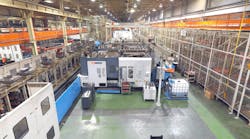Manufacturers here an increasing level of technical and professional buzz about “Big Data,” but there is very little discussion that explains what it is? Big Data refers to the vast collection of detailed information and documentation gathered and stored as a result of computing processes, which can be processed further to provide valuable insights to optimize a process or an operation. For example, Facebook collects “likes” so it can target advertisements to the right users.
According to the cloud computing software developer Asigra, 2.5 quintillion bytes of data was created daily by business and consumers worldwide during 2013. That total amount of data stored is expected to grow by 50 times by 2020.
The data itself is worthless unless information can be extracted from it, to inform decision-making, so organizations and governments are examining different ways to decipher the data to help improve their processes. The goal is to be able to use the data to generate forward-looking insights that can be acted upon to improve the way they do business. Over the next decade, data will become as important to manufacturing businesses as labor and capital.
In the past, systems left a factory never to be seen or heard of again. However, as the price of sensors, cloud computing, broadband, and data storage continues to fall, the ability for manufacturers to communicate directly with their equipment in the field is becoming more commonplace.
Beyond the references to “Big Data,” there is an increasing volume of discussion and conjecture in the Information Technology sphere regarding the “Internet of Things.” Generally, this refers to the strategies pursued by many capital goods manufacturers to build ecosystems in which their finished products host built-in sensors and monitoring software that continuously feed operating and performance back data to the OEM’s central data warehouse for processing.
Boeing is the perfect example: Boeing aircraft are constantly transmitting flight data back to Boeing HQ via satellite for analysis. Such data would be invaluable helping them to understand better what happed aboard the missing 777, Malaysia Airlines MH370.
By collecting data like this, manufacturers can spot potential equipment failure in advance by identifying early signs of potential downtime and component issues. Issues could be addressed proactively to optimize maintenance schedules, reduce warranty repair costs, and improve customer satisfaction.
The data also can be used to identify equipment that is behaving differently than the fleet, or to determine how certain failure events will affect the life expectancy of the asset or its reliability going forward. This information can help organizations maintain and optimize their assets for improved availability, utilization, and performance.
Big Data also can be used to influence the next generation of products by identifying issues that cause emergency downtime across the product fleet, and feeding those insights back into the design process, improving the manufacturing process and product quality.
Big Data from your CMMS
Today, across the U.S., manufacturers are collecting valuable information from their capital assets either directly from connected sensors, or indirectly in their CMMS by recording meter readings or logging work orders. The data is made up of two types: structured data, such as sensor readings, real-time monitoring, failure codes, and parts consumption on work orders; or unstructured data, such maintenance reports and service logs. This data offers a treasure chest of information that can improve the way we manage our assets.
How can Big Data improve the way we manage physical assets? Organizations can improve asset reliability by using CMMS data to predict component and system failure through preventive maintenance, link failures that occur close together and monitor for conditions that require further investigation. Asset managers can better plan production runs, downtime, and expected maintenance related costs based on historical data. The data can also be used to improve our decision making such as repair verses replacement based on the expected life of the asset in its current condition.
It is well documented that when cutting maintenance-related costs, optimizing spare parts inventory can deliver the biggest savings. Maintenance managers must strike a balance between reducing maintenance-related costs while maintaining equipment availability.
CMMS data can be used to help predict asset failure, to optimize quality and supply-chain processes, and to limit the number of parts onsite to what will be needed in the near future. By analyzing the rate of consumption, failure rates and lead times, parts can be procured at the right time mirroring just-in-time manufacturing methodology.
There is no doubt that Big Data will improve the way we manage our assets. OEMs will use the data to manufacture more reliable systems while CMMS data is helping maintenance technicians to work smarter. The Internet of Things may be a few years off for many organizations, but they can extract valuable information from CMMS data today.
The good news is many U.S. organizations are already mining valuable information from their CMMS data and making those decisions that drive revenue to the bottom line. CMMS software has become more intuitive and easier to use, which is critically important for organizations that need to control maintenance-related costs and improve system reliability today.
Jeff O’Brien is an industry specialist and blogger at Maintenance Assistant Inc., a supplier of web-based CMMS software for managing facilities and infrastructure equipment.









